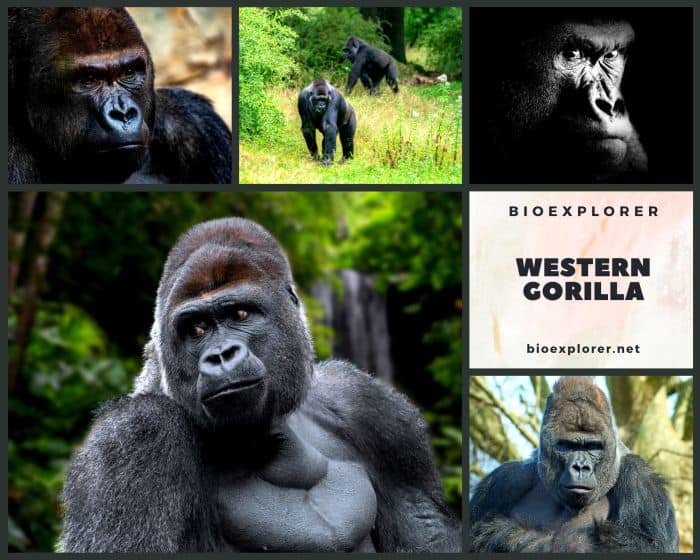
| Animalia | Primates | Hominidae | Gorilla | Gorilla gorilla |
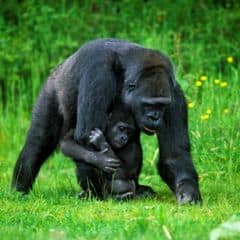

- Common Name: Western Gorilla
- Taxonomy Classification Year: 1847
- Monkey Size: 125 to 175 cm (49.2 to 68.9 in)
- Skin Color(s): Jet black
- Habitat: Forest, rainforest
- Diet: Herbivorous
- Native Countries: Central African Republic, Equatorial Guinea, Gabon, Nigeria, Democratic Republic of Congo, Angola
Western Gorilla Distribution
Western Gorilla Characteristics
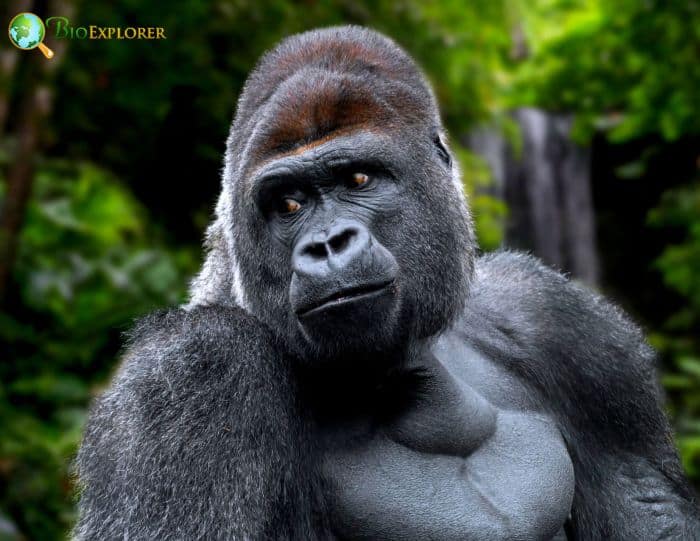
Western gorillas[1], also known as lowland gorillas, are herbivorous, primarily terrestrial apes that inhabit equatorial Africa’s Tropical Rainforests.
- Western gorillas are incredibly large and powerful primates. They have no tail and black skin. Facial features include a short snout, large nostrils, a prominent brow ridge, and small ears and eyes.
- Western gorillas have large jaw muscles and large, strong teeth. Thick, dark hair drapes the entire body except for the ears, face, feet, and hands.
- In general, older male species’ hair on the back and chest turns gray and disappears with age. This color pattern has led to older males being known as “silverbacks“.
- There are two sub-species of Western Gorilla – Western lowland Gorilla and Cross River Gorilla.
- Western gorillas have a slightly browner/grey pelage with shorter hair and are generally slightly smaller than mountain gorillas.
What Do gorillas Eat?
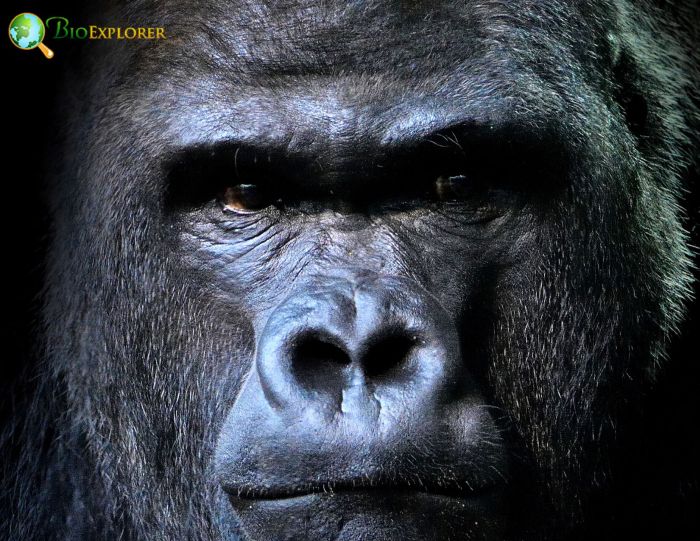
Because the Western Gorillas have been studied well in the recent times, scientists have identified the exact food sources including these organic matters[¶]:
- African Nutmeg (Pycnanthus angolensis).
- African Teak (Milicia excelsa).
- African Oil Palm (Elaeis guineensis).
- Boleko Nut (Ongokea gore).
- Butter Tree (Pentadesma butyracea).
- Djave (Baillonella toxisperma)
- Treebind (Cissus)
- Tallow Tree (Allanblackia floribunda).
- Umbrella-Tree (Maesopsis)
- Boarwood (Symphonia globulifera)
- Trichilia (Trichilia)
- Olon Tendre (Zanthoxylum heitzii).
- Red-Fruited Stinkwood (Celtis mildbraedii).
- Raffia Palm (Raphia)
- Fig (Ficus)
- Aframomum (Aframomum)
- Tropical Almond (Terminalia)
- Moambé Jaune (Annickia chlorantha).
- Velvet Tamarind (Dialium guineense).
- Rattan Palm (Eremospatha macrocarpa).
- African Mammee-Apple (Mammea africana).
- Inoi Nut (Poga oleosa).
- Emien (Alstonia boonei)
- Persimmons (Diospyros)
- Mango (Mangifera indica)
- African Breadfruit (Treculia africana).
- Black Plum (Vitex doniana).
- Chinalaurel (Antidesma)
- Wild Coffee (Psychotria)
- Guavas (Psidium)
- African Satinwood (Zanthoxylum gilletii).
- Broom Cluster Fig (Ficus sur).
- Umbrella Tree (Musanga cecropioides).
- Renealmia (Renealmia)
- Miracle Fruit (Thaumatococcus daniellii).
- Eben Tree (Dacryodes edulis).
- Mlelgueta Pepper (Aframomum angustifolium).
What Eats gorillas?
Leopards (Panthera pardus) are the primary natural predators of Westerna gorillas[§].
Western Gorilla Facts
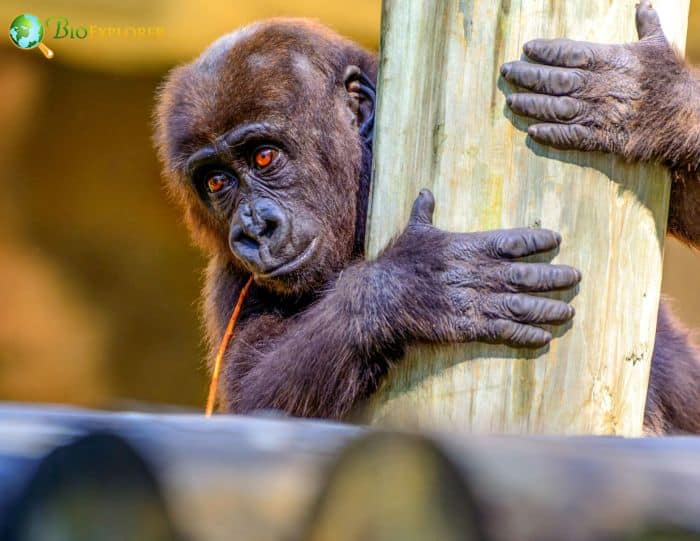
- Western gorillas are among the largest living primates and reach a height of between 1.25 and 1.8 meters, a weight of between 100 and 270 kg, and an arm span of up to 2.6 meters.
- They sometimes stand upright but walk hunched on all fours, with their hands curved and their knuckles touching the ground.
- Like humans, western gorillas do not have a set breeding season, and female species menstruate every 28 days.
- The species are typically shy, peaceful, and lovable when not threatened. However, males will stand upright and pound their fists on their chests to intimidate or show strength.
- Day and night, western gorillas build nests with twigs and leaves as cushions on the ground or in trees.
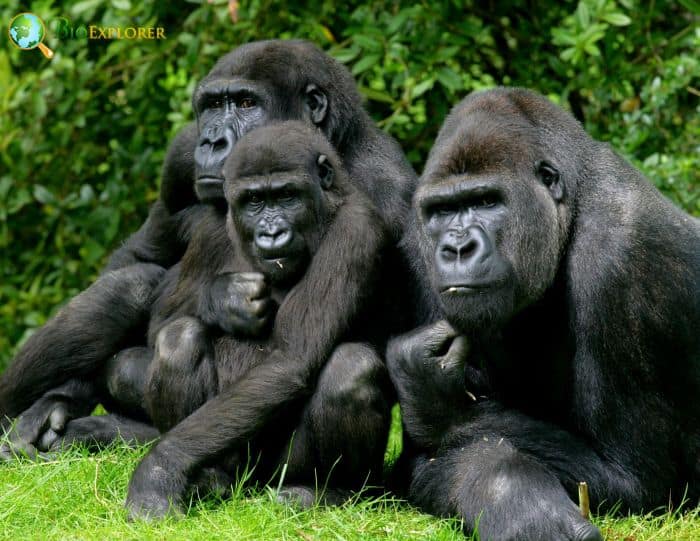
Suggested Reading: Gibbons, Gorillas, Orangutans, Bonobos & Chimpanzees
Cite This Page
APA7MLA8Chicago
BioExplorer.net. (2025, December 23). Western Gorilla. Bio Explorer. https://www.bioexplorer.net/animals/mammals/apes/western-gorilla/.
BioExplorer.net. "Western Gorilla" Bio Explorer, 23 December 2025, https://www.bioexplorer.net/animals/mammals/apes/western-gorilla/.
BioExplorer.net. "Western Gorilla" Bio Explorer, December 23 2025. https://www.bioexplorer.net/animals/mammals/apes/western-gorilla/.











